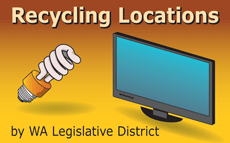
What is Product Stewardship?
Product Stewardship is an environmental management strategy that means whoever designs, produces, sells, or uses a product takes responsibility for minimizing the product's environmental impact throughout all stages of the products' life cycle, including end of life management. The greatest responsibility lies with whoever has the most ability to affect the full life cycle environmental impacts of the product. This is most often the producer of the product, though all within the product chain of commerce have roles.
Product Stewardship (PS) and Extended Producer Responsibility (EPR) are terms that are often used interchangeably to describe a long-term solution to manage waste products by shifting the responsibility for collection, transportation, and management of products away from local governments to the manufacturers (adapted from the 2007 Sonoma County Extended Producer Responsibility Implementation Plan (PDF)). Other organizations such as the Product Stewardship Institute use slightly different definitions.
Principles for Product Stewardship Policy
The NWPSC uses following principles to guide the development of product stewardship policies and legislation.
1. Producer Responsibility
1.1 All producers selling a covered product into the State are responsible for designing, managing, and financing a stewardship program that addresses the lifecycle impacts of their products including end-of-life management.
1.2 Producers have flexibility to meet these responsibilities by offering their own plan or participating in a plan with others.
1.3 In addressing end-of-life management, all stewardship programs must finance the collection, transportation, and responsible reuse, recycling or disposition of covered products. Stewardship programs must:
- Cover the costs of new, historic and orphan covered products.
- Provide convenient collection for consumers throughout the State.
1.4 Costs for product waste management are shifted from taxpayers and ratepayers to producers and users.
1.5 Programs are operated by producers with minimum government involvement.
2. Shared Responsibilities
2.1 Retailers only sell covered products from producers who are in compliance with stewardship requirements.
2.2 State and local governments work with producers and retailers on educating the public about the stewardship programs.
2.3 Consumers are responsible for using return systems set up by producers or their agents.
3. Governance
3.1 Government sets goals and performance standards following consultation with stakeholders. All programs within a product category are accountable to the same goals and performance standards.
3.2 Government allows producers the flexibility to determine the most cost-effective means of achieving the goals and performance standards.
3.3 Government is responsible for ensuring a level playing field by enforcing requirements that all producers in a product category participate in a stewardship program as a condition for selling their product in the jurisdiction.
3.4 Product categories required to have stewardship programs are selected using the process and priorities set out in framework legislation.
3.5 Government is responsible for ensuring transparency and accountability of stewardship programs. Producers are accountable to both government and consumers for disclosing environmental outcomes.
4. Financing
4.1 Producers finance their stewardship programs as a general cost of doing business, through cost internalization or by recovering costs through arrangements with their distributors and retailers. End of life fees are not allowed.
5. Environmental Protection
5.1 Framework legislation should address environmental product design, including source reduction, recyclability and reducing toxicity of covered products.
5.2 Framework legislation requires that stewardship programs ensure that all products covered by the stewardship program are managed in an environmentally sound manner.
5.3 Stewardship programs must be consistent with other State sustainability legislation, including those that address greenhouse gas reduction and the waste management hierarchy.
5.4 Stewardship programs include reporting on the final disposition, (i.e., reuse, recycling, disposal) of products handled by the stewardship program, including any products or materials exported for processing.
